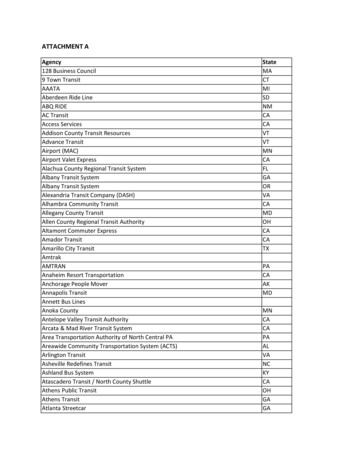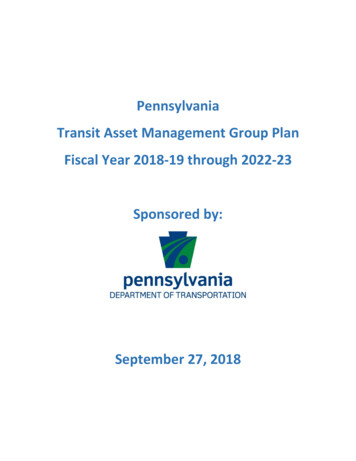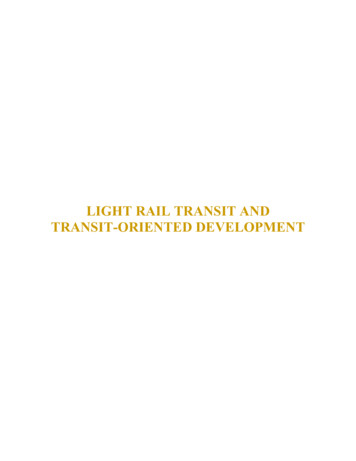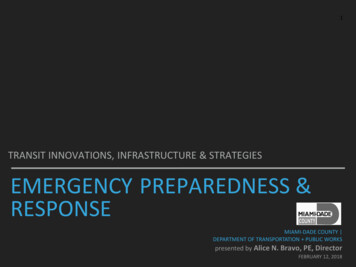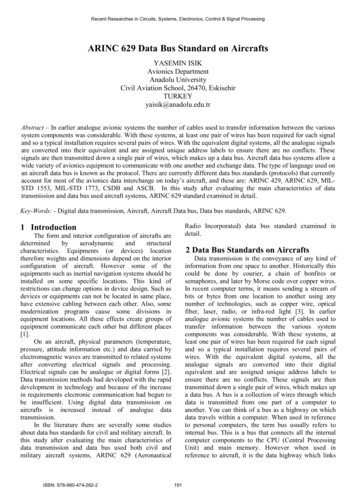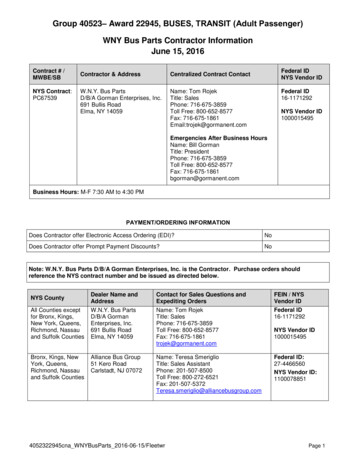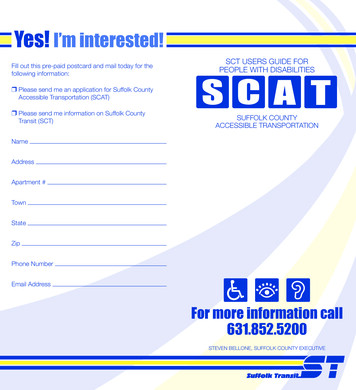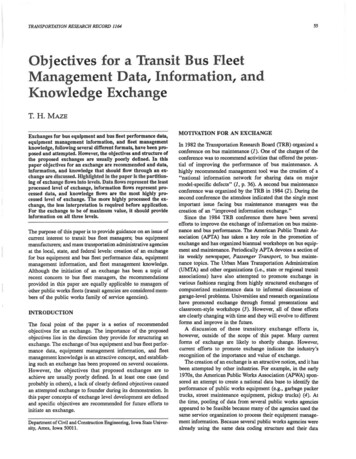
Transcription
SSTRANSPORTATION RESEARCH RECORD 1164Objectives for a Transit Bus FleetManagement Data, Information, andKnowledge ExchangeT. H.MAZEExchanges for bus equipment and bus fteet performance data,equipment management Information, and fteet managementknowledge, following several different formats, have been proposed and attempted. However, the objectives and structure ofthe proposed exchanges are usually poorly defined. In thispaper objectives for an exchange are recommended and data,information, and knowledge that should flow through an exchange are discussed. Highlighted in Ute paper ls the partitioning of exchange flows Into levels. Data flows represent the leastprocessed level of exchange, information flows represent processed data, and knowledge ftows are the most highly processed level of exchange. The more highly processed the exchange, the less Interpretation ls required before application.For the exchange to be of maximum value, it should provideinformation on all three levels.The purpose of this paper is to provide guidance on an issue ofcurrent interest to transit bus fleet managers; bus equipmentmanufacturers; and mass transportation administrative agenciesat the local, state, and federal levels: creation of an exchangefor bus equipment and bus fleet performance data, equipmentmanagement information, and fleet management knowledge.Although the initiation of an exchange has been a topic ofrecent concern to bus fleet managers, the recommendationsprovided in this paper are equally applicable to managers ofother public works fleets (transit agencies are considered members of the public works family of service agencies).INTRODUCTIONThe focal point of the paper is a series of recommendedobjectives for an exchange. The importance of the proposedobjectives lies in the direction they provide for structuring anexchange. The exchange of bus equipment and bus fleet performance data, equipment management information, and fleetmanagement knowledge is an attractive concept, and establishing such an exchange has been proposed on several occasions.However, the objectives that proposed exchanges are toachieve are usually poorly defined. In at least one case (andprobably in others), a lack of clearly defined objectives causedan attempted exchange to founder during its demonstration. Inthis paper concepts of exchange level development are definedand specific objectives are recommended for future efforts toinitiate an exchange.Department of Civil and Construction Engineering, Iowa State University, Ames, Iowa 50011.MOTIVATION FOR AN EXCHANGEIn 1982 the Transportation Research Board (TRB) organized aconference on bus maintenance (1 ). One of the charges of theconference was to recommend activities that offered the potential of improving the performance of bus maintenance. Ahighly recommended management tool was the creation of a"national information network for sharing data on majormodel-specific defects" (1, p. 36). A second bus maintenanceconference was organized by the TRB in 1984 (2). During thesecond conference the attendees indicated that the single mostimportant issue facing bus maintenance managers was thecreation of an "improved information exchange."Since the 1984 TRB conference there have been severalefforts to improve the exchange of information on bus maintenance and bus performance. The American Public Transit Association (APTA) has taken a key role in the promotion ofexchange and has organized biannual workshops on bus equipment and maintenance. Periodically APTA devotes a section ofits weekly newspaper, Passenger Transport, to bus maintenance topics. The Urban Mass Transportation Administration(UMTA) and other organizations (i.e., state or regional transitassociations) have also attempted to promote exchange invarious fashions ranging from highly structured exchanges ofcomputerized maintenance data to informal discussions ofgarage-level problems. Universities and research organizationshave promoted exchange through formal presentations andclassroom-style workshops (3). However, all of these effortsare clearly changing with time and they will evolve to differentforms and improve in the future.A discussion of these transitory exchange efforts is,however, outside of the scope of this paper. Many currentforms of exchange are likely to shortly change. However,current efforts to promote exchange indicate the industry'srecognition of the importance and value of exchange.The creation of an exchange is an attractive notion. and it hasbeen attempted by other industries. For example, in the early1970s, the American Public Works Association (APWA) sponsored an attempt to create a national data base to identify theperformance of public works equipment (e.g., garbage packertrucks, street maintenance equipment, pickup trucks) (4). Atthe time, pooling of data from several public works agenciesappeared to be feasible because many of the agencies used thesame service organization to process their equipment management information. Because several public works agencies werealready using the same data coding structure and their data
TRANSPORTATION RESEARCH RECORD 116456were processed by the same software package, the serviceorganization believed it could process several agencies' datasimultaneously and produce summary information. For example, the service group could compute the average cost perequipment operating hour or maintenance labor hours per pieceof equipment using the combined data of all of its client publicworks agencies. The summary information would serve as apoint of reference against which individual agencies couldjudge their own fleet's performance. Unfortunately, theAPWA's attempts failed, mainly because of the lengthy computer processing time required to produce summary statisticsusing early 1970s computers. However, because of the increased computing speed of current computers (late 1980s),APWA is again interested in developing a similar data pool(private communication with Robert Bugher, Executive Director of the APWA, 1987).The Department of Defense (DOD) and the National Aeronautics and Space Administration (NASA) have successfullydeveloped an extensive exchange that is operated by the Navy(5). Since the early 1970s, many DOD-NASA organizationsand contractors have been required to submit data and sts;-reliability,-andmaintainability of equipment to the Government-Industry DataExchange Program. Although the Navy does not have an exactmechanism for estimating the benefits of their data exchangesystem, users are surveyed annually and asked to estimate thecosts they avoided as a result of the exchange. In 1985 morethan 61 million in savings were reported by the system'susers; the operating cost of the exchange ·was roughly 3million (5). These results have led the Navy to conclude thatthe savings and cost avoidance accrued through the use of theexchange far exceed the exchange's operating costs and theexchange members' costs for use of the system.Levels of ExchangeClearly, exchange can be at many levels ranging from informaldiscussions of garage floor problems to structured exchange ofcomputerized data. To classify exchange levels, flows are divided into three levels: exchanges of (a) data, (b) information,and (c) knowledge. There are significant differences in theattributes of data, information, and knowledge. These terms aredefined [the definitions are adapted from those of Horton (6)]as follows:1. Data: A datum is simply the relationship between somemeasurable attribute and a specific event. For example, data onfailures of a specific bus component (e.g., transmissions) willconsist of miles traveled or hours of use (a measurable attribute) until each component failure (the event). Such failuredata may be derived by reviewing maintenance work orders orvehicle maintenance history logs. Data are the lowest level ofmaintenance and vehicle performance flow.2. Information: Information is processed data and it reducesthe uncertainty of future events. For example, if statisticalanalysis is performed on component failure data, the statistics(i.e., the mean miles between failures, the standard deviation ofmiles between failure, and other statistical parameters) can helpto determine when to expect future failures of the same component. Statistical information reduces uncertainty because it aidsin the making of forecasts of future failures.3. Knowledge: Knowledge is highly processed data, and thecreation of knowledge from data requires independent judgment and interpretation of data analysis. For example, if failuredata and repair cost data were analyzed, it might be possible tospecify a component's minimum cost replacement or overhaulinterval (e.g., overhaul engines every 250,000 IT'i or at failure).Procedures for detcnnining the optimal interval between component overhauls are knowledge. Procedures are one form ofknowledge. Other forms involve factual and judgmentalknowledge. Factual knowledge requires the study of data setsto derive facts. For example, Duffy et al. (7) compared the useof prerun inspections by transit systems and found that transitsystems with more thorough prerun inspection procedurestended to enjoy better maintenance system performance asindicated by mechanic labor hours per mile. Judgmentalknowledge is derived from observing data without the use offormai data anaiysis. For exampie, during their study of preruninspections, Duffy et al. found that, in the judgment of mostmaintenance managers, the use of prerun inspections improvesmainLenance performance (7).The distinctions among data, information, and knowledgeare quite important. The value of an exchange will be largely afunction of the format, structure, and level of exchange (i.e.,data, information, or knowledge). For example, if only raw dataare exchanged, then, for the exchange to be valuable to theparticipants, each participant must have the capability of processing raw data into either information or knowledge. Somesophisticated transit agencies may find a raw data exchangebeneficial. However, many others without complex data processing skills are not likely to find raw data worthwhile. Thus itis apparent that the utility and success of an exchange will bedependent on the data, information, and knowledge that flowinto and through the exchange and on matching the level ofexchange (i.e., data, information, or knowledge) to the requirements of exchange users.Types of ExchangeCurrent methods of exchanging bus equipment and bus fleetperformance data, equipment management information, andfleet management knowledge are relatively diffused and require quite different development approaches. For example, theAPTA conferences on Bus Equipment and Maintenance arelargely devoted to the exchange of judgmental knowledge(informal analysis derived from experience). UMTA has promoted, through a demonstration project, the exchange of statistical information through a centralized computer data base thatcontains maintenance data records from several transit agencies. Each of these represents an exchange of maintenance dataprocessed to different levels (processed to become informationor highly processed to become knowledge). The usefulness ofeach level depends on the user's ability to interpret the materials being exchanged. For example, knowledge requires littleinterpretation before it can be applied whereas pure data require a good deal of analysis and interpretation. The relativepopularity of APTA's conferences, as witnessed by their increasing attendance, leads to the conclusion that many busmaintenance managers find exchange at the knowledge level(particularly judgmental knowledge) quite useful (8, p. 6).Contrasting the various methods of exchange illustrates thatno one single means of exchange is appropriate for all users all
Mazeof the time. Sophisticated users often may only require accessto a data bank; they can perform their own analysis lo developinformation or knowledge. Others may find data processed tothe information level, or even data that are highly processed tothe knowledge level, more useful. Further, some topics may beappropria1ely exchanged at only one of the three levels. For anexchange to be of universal utility to all potential users itshould contain all three levels.EXCHANGE RECOMMENDATIONSThe first step in the development of any activity is to establish amanagement plan. A management plan should include fundamental planning components; objectives to be achieved by theoperation of the activity; rules, procedures, and programs; anda budget to govern the activity's operation. Clearly, it is premature to propose operating rules, procedures, programs, and abudget for an exchange. However, it is reasonable to recommend general objectives for an exchange of bus equipment andbus fleet performance data, equipment management information, and fleet management knowledge.PROPOSED OBJECTIVESProposed objectives for an exchange are categorized by theirLime frame. Some are continuing objectives to be accomplishedthroughout the life of the exchange. Some objectives can beaccomplished with a relatively small amount of historical data;these are short-term objectives (within 1 year). Some can onlybe accomplished with several years of historical data; these aremidterm objectives (1 to 3 years). Other objectives can beaccomplished when historical data are available for a longenough period to gain a maintenance profile over a bus's life;these are long-term objectives (5 years or more).Proposed Continuing ObjectivesClearly there are nontechnical, fundamental goals that shouldbe common to any system, such 'as deriving the greatest costsavings for the system's users, attracting a large number ofregular users, and other standard goals. However, continuoustechnical objectives for an exchange should include the following items.Development of StandardsMost transit systems have institutional and environmental differences that, to some extent, make maintenance and operatingdata from different agencies inconsistent. For example, a transitagency may have mechanics who are more qualified thanmechanics at other transit agencies, which, in tum, makes theperformance of the agency's maintenance system superior. Differences in mechanic performance may be due to factors thatare under the maintenance manager's control (such as mechanic recruiunent and training programs). Differences mayalso be due to institutional factors outside the fleet manager'scontrol. For example, the fleet manager may be unable to offerwages that will attract competent mechanics, or there may belocal socioeconomic factors such as a lack of competent dieselmechanics in the local labor pool. The extent of inconsistencies57grows even more serious when a comparison is made of localdata colJection methods, definitions, and data accuracy. Uniformity is further diminished by differences in maintenance procedures, policies, rules, and practices. Comparability is alsomade even more difficult by variations in environmental androute service factors such as duty cycles, fleet age, the terraincovered by routes, weather, and ridership levels.Because of the variations among agencies, an exchangeshould strive to develop standard procedures for data definitions and collection. By minimizing the institutional variationsin data definitions and data collection, the exchange can increase the comparability of the maintenance operations of individual users. Thus a continuous objeclive of the exchangeshould be to strive for standard definitions and data collectionprocedures. A first step toward unifonnity would be the adoption of a standard job coding system for maintenance andservicing of transit buses. If a standard code were adopted,maintenance and servicing jobs could be recorded by transitagencies using the same alphanumeric codes for job and costcategories. The code could be developed and kept up to date ina manner similar to lbat used for the American TruckingAssociations' Vehicle Mai11tena11ce Reporting Standards (9).Comprehensive Coverage of Levels of ExchangeUMTA's experimentation with a national computerized busmaintenance data base and information exchange provides anillustration of the need for comprehensive coverage of all levelsof exchange (10). The primary purpose of UMTA's system wasto take data from individual transit systems, merge the data,and derive summary statistics on a national basis (e.g., cost perrepair, labor per repair, toral maintenance costs) and possiblyeven identify specific model defects that exist in contributors'bus fleets. An individual system could then use the summarystatistics to make comparisons with its own performance.During the demonstration of UMTA's computerized database and information exchange system, a liaison board ofknowledgeable transit professionals was asked to evaluate theexchange. Members of the liaison board from large transitsystems with sophisticated maintenance management information systems and detailed data bases failed to see the value ofhaving access to a national data base because they already hadtheir own detailed performance statistics. In general, a database with more detail will have a greater number of maintenance job codes, which pennits greater accuracy in identifyingspecific maintenance jobs. When detailed data sets are mergedwith less detailed data sets, the detailed data sets are condensedand job codes are aggregated; information is Jost in the aggregation process. Liaison board members from large transitsystems thought that their own sophislicated infonnation systems were likely to provide them with more detail than would anational data base because of aggregation problems.The specific reason for larger systems being unattracced coUMTA's exchange is probably that the system only exchangedinformation at one level. The UMTA sysrem provided onlyswnmary statistics, using a national data base, that are similarto those commonly produced by individual maintenance management information systems. Further, the data would have tobe aggregated into the least common denominator of job codesand classifications used by transit agencies contributing data tomake the data from each agency compatible.
58The UMTA project foundered during its demonstration because of a lack of clearly defined objectives. After the demonstration phase, UMTA's proposed exchange was shelved. Evenat the final liaison board meeting, the board did not fullyunderstand the objective of the exchange system (10).A comprehensive exchange should provide data, information, and knowledge that an individual system could not deriveon its own. For example, a national exchange should be able toprovide transfer of lmowledge through (a) research conductedusing a natfonal dala base; (b) dissemination of one transitagency's technological innovation; (c) exchange of tectmological innovations from related industries; and (d) technical, engineering, and management training. Thus the exchange shouldstrive to comprehensively exchange data, information, andknowledge.Proposed Short-Term Objectiveswith a modest amount of data on maintenance performancefrom individual data contributors. Proposed short-term objectives include the following items.Identifying Model-Specific DefectsThe identification of model-specific defects was identified as aprimary purpose for the developmenL of a uaLional dat base inthe 1982 TRB Conference on Bus Maintenance (J ). A defect isusually identified by premature failures and possibly otherperformance attributes (e.g., high fuel consumption) that indicate a flaw in design or manufacture. Equipment flaws, or evenL that perlbelexpectations, can be brought toequipthe altention of manufacturers so that they may rectify theproblem. Also, agencies that own the equipment could be madeaware of the defect, its special conditions, and possible ways todesign out the defect (e.g., retrofits).An exchange could identify specific defects with modestamounts of data. As an example, studies could be conductedthat are similar to the Transportation Systems Center's (TSC's)reliability study of V730 transmissions in 1982 (JJ). The TSCstudy successfully identified the poor reliability of early modelsof the V730 transmission with transmission life data from onlya few large transit systems. As one equipment manufacturerpointed out, such field-collected data can be quite valuable tothe manufacturer in product improvement because "laboratoryand proving ground tests are conducted on a relatively smallnumber of samples due lo the great cosl involved . Quiteoften preventive maintenance and service practices lend to bemore idealized in proving ground teslS . " (12). A nationaldata base provides the opportunity to examine a large numberof pieces of equipment under actual operating conditions.Tools, Diagnostic Equipment, and TestsMethods of conducling maintenance are constantly being improved by the use of special tools, diagnostic uipmenl, andtest procedures. Sessions at APTA's Bus EquipmenL and Maintenance conference are often devoted to improved methods.Knowledge of these methods should be reported and disseminated through an exchange. The exchange should stress theTRANSPORTATION RESEARCH RECORD 1164importance of reporting improvements in standard formats withdata that provide evidence of the method's effectiveness andcost savings.TrainingThe exchange should seek to facilitate training at all levels:maintenance labor, front-line supervisors, and fleet management. Training can be facilitated through exchange of existingmaterials, organization of workshops, and preparation of training materials.Performance DataIn the short term, data on performance measures could becollected from transit properties. The performance measurescould serve as a basis for comparing the productivity of individual transit systems with national averages. Of course, individual transit agencies must realize that performance measureaverages may not be comparable to their own system.The idea of creating national averages (standards) for performance is attractive, and efforts to create national fleet performance standards have been made in the past. In 1951 theAmerican Transit Association established a panel of operatingexecutives to establish a set of "transit pars" for transit industry performance (including maintenance) (13). The pars werestandards for performance measurements, and they were de.signed to help management test the efficiency of their transitsystem.Proposed Midterm ObjectivesMidterm objectives are generally those that can be achievedwithin 1 to 3 years. Midterm objectives may involve the analysis of maintenance syscem performance of individual contributors of data to derive infonnation and knowledge about thedesirability of management practices of individual agencies.Management ProceduresMaintenance management practices tend to vary dramaticallyfrom one transit system to the next. For example, the preventive maintenance activities that are conducted and the frequency of preventive inspections vary greatly even amongtransit agencies with similar duty cycles and equipment. Thefr uency of preventive inspections has been commonly observed to vary from 2,000 mi between inspections (2,000-miinspections are largely for safety reasons) to 8,000 mi betweeninspections. Presumably there must be significant differences inthe cost of preventive and corrective maintenance, and thereliability of equipment, when inspections frequencies vary sowidely. However, there exists little information that, throughempirical data analysis, identifies the trade-0ffs and advantagesof various preventive maintenance strategies.A midterm study (between 1 and 3 years) of maintenanceperformance data and the corresponding practices of individualcontributors of maintenance data could identify the trade-offsand advantages of management strategies and policies. Studiescould also cover (a) management control systems used bytransit maintenance departments to better control labor time
59Mazeallocation, material dispersal, and consumable dispersal (e.g.,fuel and oil); (b) maintenance staffing levels and skill distribution and the effectiveness of training programs to update andimprove skill levels; (c) the effectiveness of conducting maintenance functions in house versus contracting them out forfleets of various sizes, maintenance labor skill levels, andmaintenance facility and maintenance equipment resources;and (d) studies of other maintenance management practices thattend to vary from one system to the next or of practices thatappear innovative and timely.Equipment InnnvationBus equipment innovation and equipment design issues arebeing researched by individual transit systems. For example, asummer 1987 "Bus Tech" in Passenger Transport reportedthat 13 transit systems were experimenting with alternative fuelsystems (i.e., methanol fuel, compressed natural gas, and propane gas) (14, p. 6). Other areas of equipment innovation include the use of new nonasbestos brake blocks, drive lineretarders, and emission control equipment. The exchange couldset standards for the reporting of experimental results andprovide engineering analysis of experimentation that appears toprovide a high level of equipment improvement.Proposed Long-Term ObjectivesLong-term objectives are those that may not be achievablewithout several years of data (5 years or more). Long-termobjectives may involve the analysis of maintenance and costdata that cover the entire life of a bus. A proposed long-termobjective involves the collection of data to permit life-cyclecost analysis to be conducted.Because buses have minimum lives that span several years,it is difficult to gain information on life-cycle costs and lifeperformance data (i.e., reliability, maintainability, and availability) over a bus's entire life without a long-term data collection effort. The long-term collection of life costs and lifeperformance data would be of tremendous assistance in theselection and specification of equipment, replacement and busrehabilitation decision making, and budgeting for future maintenance and capital costs. Knowledge of equipment performance over its life is essential for setting the most cost-effective spare ratio policies. Of course, all cost data must betempered by the data contributor's unique operating environmental conditions and duty cycle.CONCLUSIONSFor an exchange to be of the greatest value it should strive toprovide exchange at all levels: data, information, and knowledge. This is not an easy task and requires a significant effortand a long-term funding commitment. The performance of theNavy's Government-Industry Data Exchange Program illustrates the benefits of an exchange (4). However, its roughly 15-year existence and its approximately 3 million per year operating budget illustrate the significance of the support requiredto achieve the benefits that are possible through an exchange.ACKNOWLEDGMENTSThe development of this paper was supported in part through agrant to the University of Oklahoma from the Urban MassTransportation Administration, U.S. Department of Transportation. The author was a member of the faculty of the School ofCivil Engineering and Environmental Science at the Unversityof Oklahoma during the course of the research project. Theassistance of Edward J. Kannel, Professor of Civil Engineeringat Iowa State University, in the preparation of this paper is alsogratefully acknowledged.REFERENCES1. Special Report 198: Bus Maintenance Improvement. TRB, National Research Council, Washington, D.C., 1983.2. Transportation Research Circular 289: Proceedings of the 1984Bus Maintenance Productivity Workshop. TRB, National ResearchCouncil, Washington, D.C., 1985.3. Bus Fleet Management Techniques. Workshop notebook. Institutefor Urban Transportation, Transportation Research Center, IndianaUniversity, Bloomington.4. Equipment Management Manual. Institute for Equipment Services. American Public Works Association, Chicago, fil., 1975,Chapter 5: APWA Data Bank Standards.5. Annual Participant Progress Report. Government-Industry DataExchange Program, GIDEP Operational Center, Corona, Calif.,1985.6. F. W. Horton. Information Resources Management: Concept andCases. Association for Systems Management, Cleveland, Ohio,1979.7. J. Duffy, J. F. Foerster, and S. Puente. Management of Transit BusPrerun Inspections. In Transportation Research Record 1066,1RB, National Research Council, Washington, D.C., 1986, pp.7- 12.8. San Antonio Workshop Sets Attendance Record. PassengerTransport: Bus Tech, Vol. 45, No. 16, April 20, 1987.9. ATA Vehicle Maintenance Reporting Standards (VMRS). American Trucking Associations, Alexandria, Va., undated.10. Bus Maintenance Data Base Liaison Board Meeting Minutes andReports. American Public Transit Association, 1986.11. T. Comparato, N. Harringon, R. Ow, and F. Seekell. ReliabilityEval11alion of V730 Transmission. Report UMTAMA-06-0120-92-6, Transportation Systems Center, U.S. Department of Transportation, Cambridge, Mass., 1982.12. J. C. Arndt, R. A. Burton, and S. L. Schwalm. How VMRS Helpsthe Manufacturers. SAE Technical Paper 780269. Society of Automotive Engineers, Inc., Warrendale, Pa., 1978.13. Report of the Committee on Standard Paris lo ATA Annual Meeting 1952. American Transit Association, Washington, D.C., 1952.14. APTA Focuses on Issue of Environmental Maintenance. Passenger Transport: Bus Tech, Vol. 45, No. 26, June 29, 1987.
Objectives for a Transit Bus Fleet Management Data, Information, and Knowledge Exchange T. H. MAZE Exchanges for bus equipment and bus fteet performance data, equipment management Information, and fteet management knowledge, following several different formats, have been pro pose
